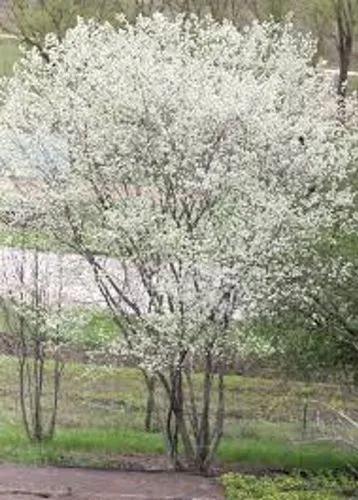Eucalyptus globulus is a tree that typically grows to a height of 45 m (148 ft) but may sometimes only be a stunted shrub, or alternatively under ideal conditions can grow as tall as 90–100 m (300–330 ft), and forms a lignotuber. The bark is usually smooth, white to cream-coloured but there are sometimes slabs of persistent, unshed bark at the base. Young plants, often several metres tall, and coppice regrowth have stems that are more or less square in cross-section with a prominent wing on each corner. Juvenile leaves are mostly arranged in opposite pairs, sessile, glaucous elliptic to egg-shaped, up to 150 mm (5.9 in) long and 105 mm (4.1 in) wide. Adult leaves are arranged alternately, the same glossy to dark green on both sides, lance-shaped or curved, 150–300 mm (5.9–11.8 in) long and 17–30 mm (0.67–1.18 in) wide on a petiole 1.5–6 mm (0.059–0.236 in) long. The flower buds are arranged singly or in groups of three or seven in leaf axils, sometimes sessile or on a short thick peduncle. The individual buds are also usually sessile, sometimes on a pedicel up to 5 mm (0.20 in) long. Mature buds are top-shaped to conical, glaucous or green, with a flattened hemispherical, warty operculum with a central knob. Flowering time varies with subspecies and distribution but the flowers are always white. The fruit is a woody conical or hemispherical capsule with the valves close to rim level.
Eucalyptus Care
Eucalyptus genus



How to Care for the Plant

Water

Water your eucalyptus plant with some regularity. While it can be considered partially drought-tolerant once established, it really doesn't like to be left dry for long periods and may even begin to drop leaves or branches. A good rule of thumb is to test the dryness of the soil to a depth of about 4 inches; if it feels dry to the touch, it's time to water.

Fertilizer

If you're growing your plant outdoors in your landscape, chances are it won't need any additional fertilizer applications. That being said, eucalyptus that's being grown in containers (either indoors or outdoors) can benefit from an application of a balanced liquid fertilizer each spring.

Sunlight

Eucalyptus likes a lot of light, so settle your plant somewhere in your landscape that receives at least 8 to 10 hours of bright sunlight daily. Likewise, eucalyptus plants grown indoors should be kept near a window that gets plentiful sunlight.

Soil

Plant your eucalyptus in a soil mixture that is moist but well-draining. When potting your eucalyptus in containers outdoors (or indoors for that matter), it's important to choose vessels that have ample drainage holes at their base. If you're planting eucalyptus directly in your garden and have no plans of containing it, make sure the area can accommodate its eventual size.

Temperature

Eucalyptus prefers warm temperatures and humidity levels that mimic its natural Australian environment. If you're planting your eucalyptus in a container, make sure to bring the plant indoors if you're expecting prolonged temperatures below 50 degrees Fahrenheit.

Additional

Eucalyptus is one of the most toxic plants for small pets, especially dogs. The trouble comes from the plant's oils, also known as eucalyptol, which can irritate the gastrointestinal system and cause many issues for your pet. If you notice your animal exhibiting any of the below symptoms, contact your vet or emergency services immediately.

Popularity

721 people already have this plant 169 people have added this plant to their wishlists
Discover more plants with the list below
Related articles






